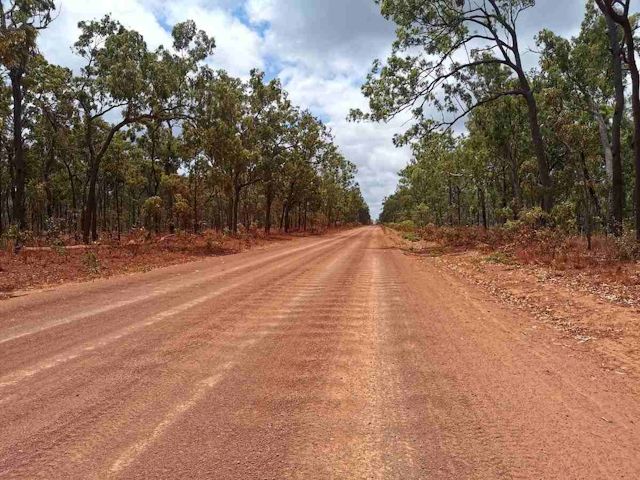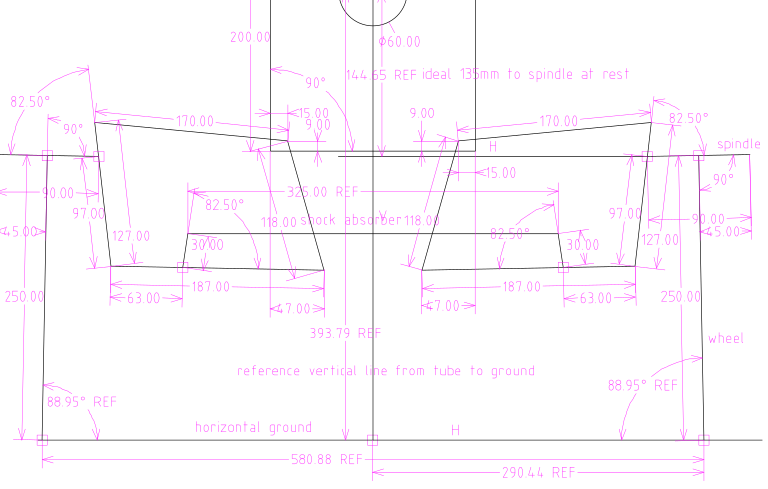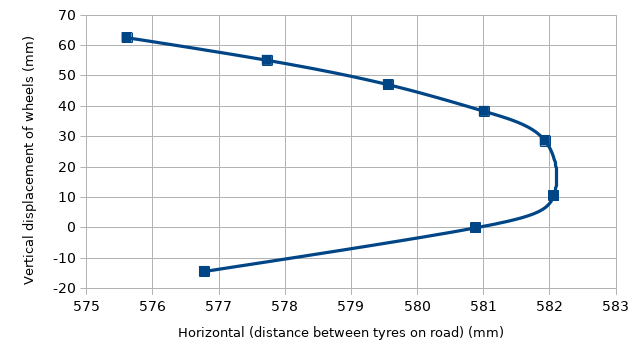Tyre scrubbing on trike with suspension
Continuing the custom tadpole trike project, with solar panels and leaning front suspension. Previous blog post:
https://bkhome.org/news/202310/design-of-front-suspension-for-leaning-recumbent-trike.html
...in that post, there is a link to a video with an animation of a leaning trike design. Here it is again:
https://www.youtube.com/watch?v=c3a0sSPOhb0
...watch just the first 20 seconds, and notice what happens when both
wheels are equally deflected. That is, weight has been applied downward
so both wheels are moved vertically by an equal amount. Notice the
distance between the tyres on the ground: they move inward, toward each
other.
This sideways movement of the tyres on the road surface is known as
"scrubbing". It happens in a car when you corner hard; the tyres scrape
sideways on the road. Ripping off tread.
It is not just when cornering; most suspension designs exhibit
scrubbing when the wheels hit a bump in the road. I want to optimise my
custom trike to handle corrugated gravel roads, in which both wheels hit
the same bump and get deflected upwards equally. The situation as shown
in the above video.
There are photos of corrugated roads in rural Australia posted to this blog. Here is another, taken at Cape York (photo from here):

...I chose this photo as it is representative of most corrugated
roads; fairly "mild" ripples, but still car-destroying. Here is an
example of more extreme ripples (photo from here):

...these roads will quickly erase the tread on the tyres for the
suspension design in the above video. I have looked at other trike front
suspension designs (leaning and non-leaning) and they all have this
scrubbing effect. The ones that I have seen anyway, though mostly I have
studied personal projects, not commercially manufactured trikes.
My trike design has double-wishbones, very short length. There is
going to be scrubbing. The focus is on minimizing it for the particular
situation of corrugated roads. Here is the latest SolveSpace design:

...riding on a corrugated road, the wheels hit a ripple and get
deflected upward. Using SolveSpace, I plotted values, vertical
deflection of the wheels against scrubbing on the road surface:

...the "0" on the vertical axis represents the rest point; riding along
on a smooth road surface. Hit a ripple and the wheels deflect upward. A
vertical deflection of 10mm causes just over 1mm scrubbing (the
horizontal axis). 40mm vertical deflection and scrubbing is back to
almost zero. 60mm (2.4 inches) vertical deflection and the tyres on the road surface
will have scrubbed inward (toward each other) about 5mm; that's about
2.5mm on each tyre.
After a lot of playing with SolveSpace, that seems optimum. It is a
compromise. It might even be negligible. I optimized for 40mm (1.6 inches)
vertical travel, the tyres will wobble about 1mm outward then 1mm
inward (0.5mm on each tyre). As deflection increases, camber will increase negatively (top of
wheels moving inward), and will probably run a fairly low tyre pressure
on those roads, both of which may lessen the effect of the scrubbing.
So, my reasoning is that 0.5mm per-tyre either way is negligible.
Note, I am deliberately limiting the vertical travel to 50-60mm
maximum, so no cushioning for bigger bumps. There are issues with
steering linkages; maybe trouble if too much vertical travel,
particularly with the tie-rods and toe setting.
I'm a suspension neophyte, so the above is just my
beginner's reasoning. We shall see. Get it wrong, and the tyre tread
will get worn out very quickly.
Tags: light
